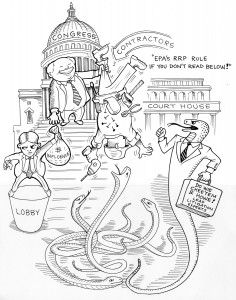THE EPA AND THE SNAKE PIT OF LITIGATION!
November 1, 2013 1:10 pmIf you are a contractor, tradesman, maintenance worker or property owner the lobbyists, in conjunction with the Government, have literally thrown you into the snake pit of litigation!!!
As a nationally respected lead-based paint subject matter expert and having performed thousands of lead inspections, site assessments and abatement projects, I am sharing with each reader my belief that the federal government’s lack of requiring trades to collect dust wipe clearance samples upon completing a paint disturbance under EPA’s Lead Renovation, Remodeling and Repair Rule (RRP) (April 2010) is throwing you into the Snake Pit of litigation and trial lawyers. You ask why?
On July 15, 2011, the United States Environmental Protection Agency (EPA) published their final amendments to EPA’s RRP Rule. Within the final amendments, EPA made it clear that lead dust wipe clearance sampling collection was NOT required and contractors are NOT responsible to perform the very subjective and very misleading Cleaning Verification test in rooms where work (paint disturbances) was not required, contracted for or performed in. Sounds like a great situation, “Right” – “WRONG! VERY VERY WRONG!!” 
WRONG, because what you and the Lobbyist are probably not as familiar with or don’t realize is there has been a long time, well established, well litigated, federally regulated dust lead standard under the Toxic Substance Control Act (TSCA) that states 40 micrograms of lead dust per square foot is considered a Toxic Level and a clear Dust Lead Hazard. “And so what” you might be asking. Well the “so what” is that it is a well known fact that dust levels of 40 micrograms per square foot can EASILY be tracked into a property from general day to day life, walking, working …. and so on. It is also a well documented fact that it is very difficult, if not impossible, for most to see 40 micrograms of lead dust particulate with the naked eye since its particulate size is so small (approx. half the size of a single grain of Sweet & Low).
So imagine this. You are hired by a client to renovate a single bathroom in a pre-1978 property. The renovation is a complete demo and redo. As a professional who takes great pride in their work and professionalism, you are properly certified by the EPA as a Certified Lead Renovator and you yourself are an EPA Certified Lead Supervisor. You have properly completed all of the regulated paperwork (pre-renovation notification, chemical test kit, worker training, checklist….) and upon completion of the bathroom renovation and cleanup, which I should say “looks great”, you perform the RRP rule required Cleaning Verification and based on your visual inspection it passes. You then thank the client for allowing you this opportunity. They tell you they love it and you request final payment. They pay and you go on to the next project with another satisfied customer.
THEN WHEN YOU LEAST EXPECT IT, that prior satisfied client becomes concerned or just questions about whether or not any hazardous levels of lead dust could still be present in their property. So they elect to collect lead dust wipe samples and have them analyzed by an AIHA NLLAP accredited lab who determines that several of the samples have failed the test. Regulated levels of toxic lead dust remain within the property and NOT necessarily in the bathroom, the only room you were required to clean and perform Visual Verification within in accordance with the final rule.
As I am sure you can imagine this story continues and plays out with lawyers, legal bills, expert testimony and lots of wasted time and gray hairs!!
So I can appreciate why at first glance it would be perceived as a “win”, not to have to collect laboratory analyzed dust wipe clearance samples for lead paint disturbance activities. I can also appreciate why not being responsible for cleaning areas of the property that you did not perform work in could also be considered a “win”. The problem arises when you did not PROVE PRIOR to performing the work (paint disturbances) that these pre-existing levels of toxic lead dust existed. Once you have performed any paint disturbances within the property without having baseline dust lead levels in the areas you are NOT working in, you just accepted ownership and unfortunately full responsibility for these other rooms toxic lead dust levels after the fact!!! And it is incredibly hard to argue otherwise, or for that matter prove otherwise!!!
Since the RRP laws requires all such trades who disturb pre-1978 painted surfaces (residential & child occupied) to be EPA certified as a Lead-Safe Renovator, it will be very difficult in the future to argue you were not participating in the disturbance of lead-based paint. Unfortunately, like most general trade oriented insurance policies they contain Lead-Based Paint exclusions. Consequently, NO coverage for the claim when one arises. To assure proper lead-based paint coverage, I strongly recommend you consider discussing this with your insurance agent just in case you don’t take my advice about collecting pre-work baseline lead dust level samples.
So as they say and in this expert’s opinion, the best offense is a good defense. Laboratory analyzed clearance lead dust wipes are the cheapest insurance around! My best recommendation and suggestion to ALL THE IMPACTED entities, is if you think the property might contain Lead Paint, if you think the residents could be considered higher risk (family with small children, pregnant bearing age…) take lead dust wipes prior to beginning the project and should any exceed the hazardous level (fail) you can address such concerns prior to beginning the project and prior to any litigation proceedings. Who knows, they might even consider hiring you to properly clean these areas in addition to the bathroom renovation.
What are your thoughts?
